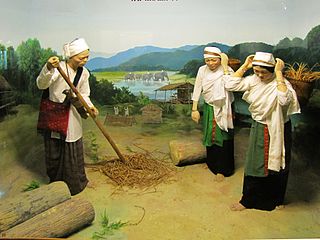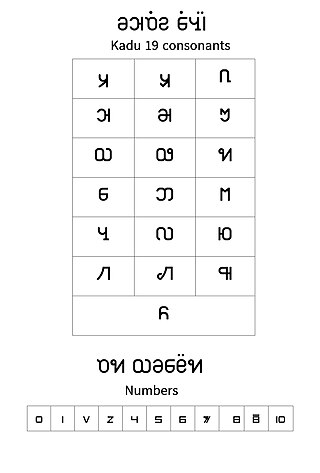
The Shan people, also known as the Tai Long or Tai Yai, are a Tai ethnic group of Southeast Asia. The Shan are the biggest minority of Burma (Myanmar) and primarily live in the Shan State of this country, but also inhabit parts of Mandalay Region, Kachin State, Kayah State, Sagaing Region and Kayin State, and in adjacent regions of China, Laos, Assam and Meghalaya, Cambodia, Vietnam and Thailand. Though no reliable census has been taken in Burma since 1935, the Shan are estimated to number 4–6 million, with CIA Factbook giving an estimate of five million spread throughout Myanmar which is about 10% of the overall Burmese population.

The Ahom script or Tai Ahom Script is an abugida that is used to write the Ahom language, a dormant Tai language undergoing revival spoken by the Ahom people till the late 18th-century, who established the Ahom kingdom and ruled the eastern part of the Brahmaputra valley between the 13th and the 18th centuries. The old Ahom language today survives in the numerous manuscripts written in this script currently in institutional and private possession.

The Ahom language or Tai-Ahom language is a dead language, that was formerly spoken by the Ahom people, but which is currently undergoing a revival. Ahom is an important language in Tai studies. It was relatively free of both Mon-Khmer and Indo-Aryan influences and has a written tradition dating back to the 13th century.

The Shan language is the native language of the Shan people and is mostly spoken in Shan State, Myanmar. It is also spoken in pockets in other parts of Myanmar, in Northern Thailand, in Yunnan, in Laos, in Cambodia, in Vietnam and decreasingly in Assam and Meghalaya. Shan is a member of the Tai–Kadai language family and is related to Thai. It has five tones, which do not correspond exactly to Thai tones, plus a sixth tone used for emphasis. The term Shan is also used for related Northwestern Tai languages, and it is called Tai Yai or Tai Long in other Tai languages. Standard Shan, which is also known as Tachileik Shan, is based on the dialect of the city of Tachileik.
Tshangla is a Sino-Tibetan language of the Bodish branch closely related to the Tibetic languages. Tshangla is primarily spoken in Eastern Bhutan and acts as a lingua franca in the region; it is also spoken in the adjoining Tawang tract in the Indian state of Arunachal Pradesh and the Pemako region of Tibet. Tshangla is the principal pre-Tibetan language of Bhutan.

Northern Qiang is a Sino-Tibetan language of the Qiangic branch, more specifically falling under the Tibeto-Burman family. It is spoken by approximately 60,000 people in East Tibet, and in north-central Sichuan Province, China.
Dulong or Drung, Derung, Rawang, or Trung, is a Sino-Tibetan language in China. Dulong is closely related to the Rawang language of Myanmar (Burma). Although almost all ethnic Derung people speak the language to some degree, most are multilingual, also speaking Burmese, Lisu, and Mandarin Chinese except for a few very elderly people.

The Tai Khamti, also known as the Hkamti Shan or simply as Khamti, are a Tai ethnic group of India, China and Myanmar. The Tai-Khamti are followers of Theravada Buddhism. The Tai-Khamti have their own script for their language, known as 'Lik Tai', which originated from the Shan (Tai) script of Myanmar. Their mother tongue is known as Khamti language. It is a Tai language, closely related to Thai and Lao.
Jingpo or Kachin is a Tibeto-Burman language of the Sal branch spoken primarily in Kachin State, Myanmar; Northeast India; and Yunnan, China. The Jingpo peoples, a confederation of several ethnic groups who live in the Kachin Hills, are the primary speakers of Jingpo language, numbering approximately 1,000,000 speakers. The term "Kachin language" may refer to the Jingpo language or any of the other languages spoken by the Jingpo peoples, such as Lisu, Lashi, Rawang, Zaiwa, Lhao Vo, and Achang. These languages are from distinct branches of the highest level of the Tibeto-Burman family.

S’gaw, S'gaw Karen, or S’gaw K’Nyaw, commonly known as Karen, is a Sino-Tibetan language spoken by the S'gaw Karen people of Myanmar and Thailand. A Karenic branch of the Sino-Tibetan language family, S'gaw Karen is spoken by over 2 million people in Tanintharyi Region, Ayeyarwady Region, Yangon Region, and Bago Region in Myanmar, and about 200,000 in northern and western Thailand along the border near Kayin State. It is written using the S'gaw Karen alphabet, derived from the Burmese script, although a Latin-based script is also in use among the S'gaw Karen in northwestern Thailand.

Old Burmese was an early form of the Burmese language, as attested in the stone inscriptions of Pagan, and is the oldest phase of Burmese linguistic history. The transition to Middle Burmese occurred in the 16th century. The transition to Middle Burmese included phonological changes as well as accompanying changes in the underlying orthography. Word order, grammatical structure and vocabulary have remained markedly comparable, well into Modern Burmese, with the exception of lexical content.

Kadu or Kado(Kadu:); is a Sino-Tibetan language of the Sal branch spoken in Sagaing Region, Myanmar by the Kadu people. Dialects are Settaw, Mawkhwin, and Mawteik [extinct], with 30,000 speakers total. Kadu is considered an endangered language, and is closely related to the Ganan and Sak languages.

The Southwestern Tai or Thailanguages are a branch of the Tai languages of Southeast Asia. Its languages include Central Thai (Siamese), Northern Thai (Lanna), Lao, Shan and others.
The Aiton language or Tai Aiton language is spoken in Assam, India, in the Dhonsiri Valley and the south bank of the Brahmaputra. It is currently classified as a threatened language, with fewer than 2,000 speakers worldwide. Its other names include Aitonia and Sham Doaniya.
The Phake language or Tai Phake language is a Tai language spoken in the Buri Dihing Valley of Assam, India. It is closely related to the other Southwestern Tai languages in Assam: Aiton, Khamti, Khamyang, and Turung.

Jad (Dzad), also known as Bhotia and Tchhongsa, is a language spoken by a community of about 300 in the states of Uttarakhand and Himachal Pradesh, in India. It is spoken in several villages, and the three major villages are Jadhang, Nelang and Pulam Sumda in the Harsil sub-division of the Uttarkashi District. Jad is closely related to the Lahuli–Spiti language, which is another Tibetic language. Jad is spoken alongside Garhwali and Hindi. Code switching between Jad and Garhwali is very common. The language borrows some vocabulary from both Hindi and Garhwali. It is primarily a spoken language.
Proto-Sino-Tibetan (PST) is the hypothetical linguistic reconstruction of the Sino-Tibetan proto-language and the common ancestor of all languages in it, including the Sinitic languages, the Tibetic languages, Yi, Bai, Burmese, Karen, Tangut, and Naga. Paul K. Benedict (1972) placed a particular emphasis on Old Chinese, Classical Tibetan, Jingpho, Written Burmese, Garo, and Mizo in his discussion of Proto-Sino-Tibetan.
Taman is an extinct Sino-Tibetan language that was spoken in Htamanthi village in Homalin Township, Sagaing Region, northern Myanmar. It was documented in a list of 75 words in Brown (1911). Keisuke Huziwara (2016) discovered an elderly rememberer of Taman in Htamanthi who could remember some Taman phrases as well as a short song, but was not fluent in the Taman language. However, no fluent speakers of Taman remained in the area.
Proto-Karenic or Proto-Karen is the reconstructed ancestor of the Karenic languages.

The Shan alphabet is a Brahmic abugida, used for writing the Shan language, which was derived from the Burmese alphabet. Due to its recent reforms, the Shan alphabet is more phonetic than other Burmese-derived alphabets.











